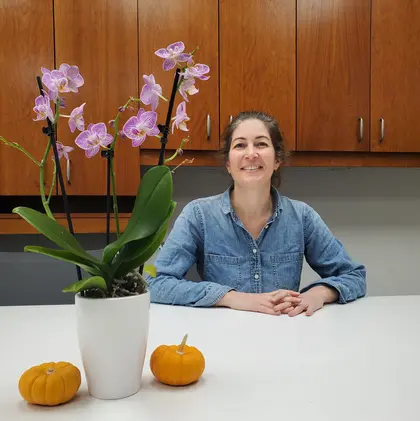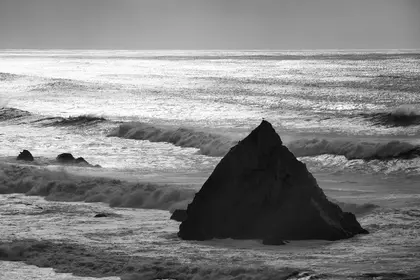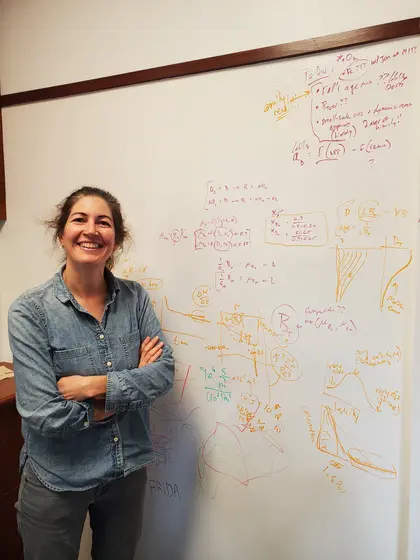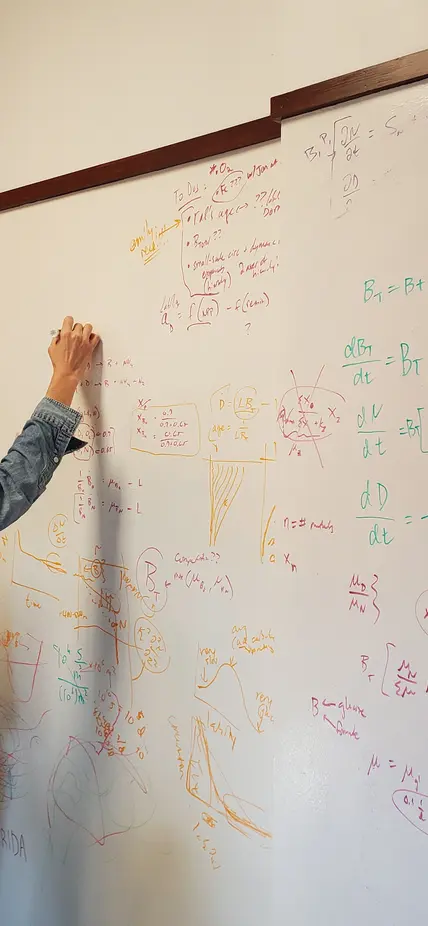
Q: Tell us about the work your lab is doing.
Emily Zakem: Everything that we do in the group is trying to connect microbial activity to the large-scale biogeochemistry, and ultimately, to connect it to the climate system. So, we're trying to ask: How can we most simply—but very mechanistically and dynamically—represent microbial interactions at the large scale.
My work really aims to bridge the micro scale with a global scale, which could potentially inform how we model the Earth system and its carbon cycle and nutrient cycling. For the bulk of what I do, the aim of it is just to understand the systems, because I feel that unless we understand the current system, we can't meaningfully predict the future system. And there's so much that we don't understand about the ocean.
Another thing that I'm trying to do with my research is determine how we connect sequencing datasets with these biogeochemical models and get it all in the same currency or in the same units. They don't interface smoothly with one another yet. So, we have to figure out how get two different data sets like that to talk to each other. There are a lot of people who say, “well, biology is too complex, we can never figure out how to organize it systematically.” But what I'm trying to do is find the simplest possible skeleton of how biology works.
Many of these methodologies actually come from wastewater treatment plants, where people are really motivated to understand quantitatively how microbes impact the environment, for practical reasons. We're sort of borrowing a lot of the approaches that have been developed in that field, thinking of the ocean as a big bioreactor that’s much slower and more dilute.
Q: What does a typical day of research look like for you?
Emily Zakem: It depends on the stage of the project. But I guess the most interesting stage is when we sort of have a question, and we're trying to figure out how to go about answering it. And it usually involves being on the board and writing down some equations about how things work, such as some simple equations about how a microbial population grows and dies. We're a bit biased towards thinking about the growth side, but the death side is also important. So, we’re putting together those sorts of equations, doing some simple analysis to determine the simple patterns that emerge.

Q: How do you decide which questions to tackle?
Emily Zakem: It’s hard to find the right balance between something being important and there being room in the field to actually make progress. You don’t want to pursue something where there’s 1,000 other people in the field who have already written papers about it, but you also want it to be tractable and useful. So, I think I think it is a challenge to find that balance, especially in for questions that are motivated by how the climate is going to change and what that means for people.
Q: Could there be a scenario someday in the future where all the questions that can be probed with your kind of methodology have been done? Or is it sort of an infinite process?
Emily Zakem: When you think about microbial metabolism, and the information that we have in sequencing datasets, it's so deep. There's so much micro diversity, meaning there are thousands of genetically distinct populations out there.
So, what I hope we can do is ultimately build biogeochemical models of the Earth system that we do think are accurate representations of all the important microbial processes from a climate perspective.

Q: How did you get into ocean biogeochemistry?
Emily Zakem: I was an art major in undergrad. I specialized in drawing and painting but ended up taking a food system class taught by ecologists my fourth year. And I was suddenly like, “wow, science can be cool and relevant to the world!” So, I took more classes and did some help with research. And at the end of undergrad, when finished with my drawing and painting major, I knew that I wanted to come back to grad school and study science.
I did a master's in isotope biogeochemistry. It was an interesting interdisciplinary program linking policy, philosophy, sociology, and science. It was really a good segue for me. As part of that program, I took a physical oceanography class, and I just loved it. It introduced me to a whole new world that I didn't even know existed. After that, I knew I wanted to do oceanography for a Ph.D. program, and I was just reading through all the different ocean programs and found this one group, my eventual advisor’s group, and their work struck me as being really cool. So, I started working with them and that was it.
Q: Do you ever apply your drawing and painting skills to marine systems or microbes or anything like that?
Emily Zakem: There were people when I was in grad school doing watercolors of microbes, but that just isn’t the way that those worlds collided for me.
But I do think there is a strong correlation between what I learned from my art major and my eventual graduate school successes in research. In school, if you take a painting class or sculpture class, the professor imparts you with some skills and then leaves you to use them to explore the projects that you want to pursue. And that’s a lot like research in that both are unstructured, and self-directed, taking learned skills and figuring out what you want to do with them. In graduate school, a lot of people can’t get past the spoon-fed stage, where your job is to memorize and regurgitate information and to do well on tests. But that transition was really easy for me, so I think that’s where the overlap lies.
I was always a little too analytical, I think, to be a good artist. I was just always overthinking things a little too much. But in science that's what you need: Please, overthink. That's what we all do.
Q: When you think about your work or your field overall, what do you see changing or developing over the next decade or two?

Emily Zakem: I think everyone's thinking about how best to put microbes in climate models. We know so much more about microbes now. Sequencing data is just changing the field so fast. And we know there's currently bad representation of microbes in climate models. But how to do it? That's a good question.
Physical climate has a whole series of work about model hierarchy, determining how complex a model needs to be in spatial resolution. And I think that we could do that with metabolic resolution. I think there's a lot more quantitative analysis that can emerge from the sequencing datasets. I think there's amazing work on the horizon in trying to synthesize that and quantify that and turn that into predictions of how fast microbes grow and how quickly they transform substrates and environment.
Q: And do you see any potential new technology emerging that would be a similar kind of game changer?
Emily Zakem: Computers are getting faster, too. And some people are trying to use computer systems that are greener, using less energy to make predictions.
Q: Are there interesting problems that you need new technology to address?
Emily Zakem: If you could have satellites that could penetrate the deep ocean that would be a game changer. Right now, we’re very interested in how much carbon and heat and other things reach the deep ocean and it’s hard to measure that. So hopefully NASA, and our friends down the road at JPL, are working on that.
